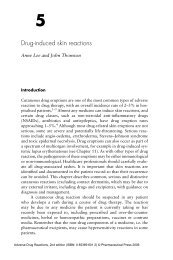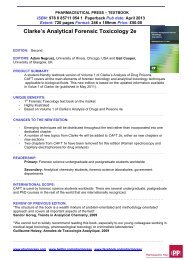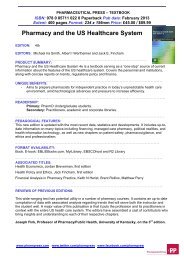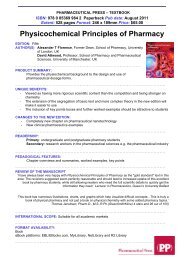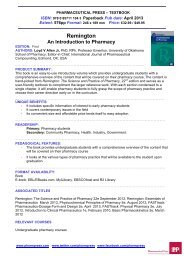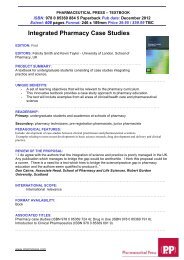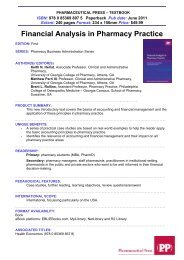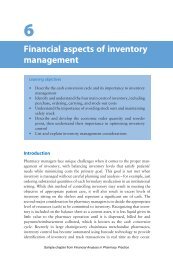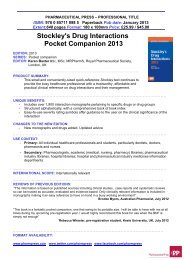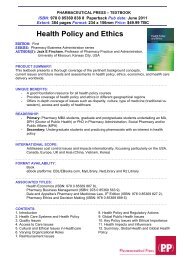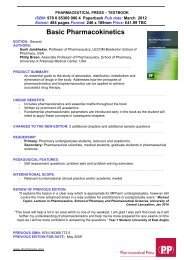11 Chap 11 (bc/d) - Pharmaceutical Press
11 Chap 11 (bc/d) - Pharmaceutical Press
11 Chap 11 (bc/d) - Pharmaceutical Press
You also want an ePaper? Increase the reach of your titles
YUMPU automatically turns print PDFs into web optimized ePapers that Google loves.
206 <strong>Chap</strong>ter <strong>11</strong> • Formulation and physical properties of soft capsules<br />
Active compounds that have been successfully<br />
formulated as a microemulsion preconcentrate<br />
in softgels are ciclosporin and the protease<br />
inhibitor ritonavir. A patent has also been filed<br />
for ibuprofen (Rouffer, 2001). Examples of microemulsion<br />
pre-concentrate soft gelatin capsule fill<br />
formulations are given in Table <strong>11</strong>.2, indicating<br />
the use of hydrophilic co-solvents such as ethanol<br />
and propylene glycol.<br />
Formulation strategies<br />
Soft gelatin capsule formulation strategies have<br />
to consider the specific shell/fill interactions that<br />
may occur during manufacture, drying and on<br />
storage and control their rate and extent to<br />
achieve a stable product.<br />
Two major types of interactions have to be distinguished:<br />
• Chemical reactions of fill components with<br />
the gelatin and the plasticizer<br />
• Physical interactions, i.e. migration of fill<br />
components in or through the shell and vice<br />
versa.<br />
Cross-linking of gelatin leading to solubility<br />
problems of the shell is a well-known problem<br />
associated with the encapsulation of drugs containing<br />
reactive groups such as the aldehyde<br />
group. It can be successfully reduced by the use of<br />
succinylated gelatin, an approach that is often<br />
used for health and nutrition products, and in<br />
some countries even for pharmaceutical products.<br />
Esterification and transesterification of drugs<br />
with polyols present another unwanted chemical<br />
reaction that may occur. Since glycerol is more<br />
reactive than other polyols, glycerol-free shell<br />
formulations and/or the addition of polyvinyl<br />
pyrrolidone to the fill (Gullapalli, 2001) are preferred<br />
to reduce this problem.<br />
The rate and extent of physical shell/fill interactions<br />
depend strongly on the qualitative and<br />
quantitative composition of both, the shell and<br />
the fill. As a general rule, the water content of the<br />
fill should not exceed a critical value of about 5%.<br />
Fill formulations simply composed of a lipophilic<br />
drug in a lipophilic oily vehicle do not<br />
interact with the hydrophilic gelatin capsule<br />
shell at any time, i.e. either during production or<br />
on storage. The proper choice of the shell composition<br />
therefore only depends on the stability<br />
of the active ingredient, the capsule size, shape<br />
and end use and the anticipated storage conditions.<br />
For very soft capsules and those stored at<br />
ambient conditions, glycerol is the plasticizer of<br />
choice. For more rigid soft gelatin capsules and<br />
those intended to be used in hot and humid<br />
climates, glycerol/sorbitol blends are preferred.<br />
The latter is also valid for soft capsules containing<br />
oxygen-sensitive compounds in the fill (Hom<br />
et al., 1975; Meinzer, 1988). In any case, the P/G<br />
ratio is adjusted to the size and intended use of<br />
the capsules. To obtain light protection, the shell<br />
Table <strong>11</strong>.2 Examples of microemulsion preconcentrate compositions for soft gelatin capsules<br />
Active ingredient Fill excipients<br />
Ciclosporin Ethanol<br />
Propylene glycol<br />
Mono-, di-, triglycerides from corn (maize) oil<br />
Polyoxyethylene (40) hydrogenated castor oil<br />
DL-alpha-tocopherol<br />
Ritonavir Ethanol<br />
Propylene glycol<br />
Polyoxyethylene (35) castor oil<br />
Polysorbate 80<br />
Polyoxyethylene/glyceryl mono-, di-, tri-alcanoate (C8–C18)<br />
Medium chain triglycerides<br />
Citric acid



